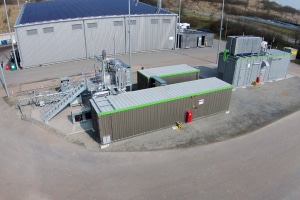Micro-organisms provide more flexibility than common catalysts, and the methane produced by them is relatively pure. Additionally, the investment costs for Power-to-Gas systems can be lowered by using transformers and power as well as gas network connections of already existing biogas and wastewater treatment plants. This field of study, however, still requires more research to be done, even for the newly built Power-to-Gas plant by Viessmann, which has been feeding into the public gas grid in Allendorf since the middle of last March.
The placid Allendorf community at the Eder in Germany’s federal state of Hesse has its own airfield, although no regular or charter flights make their landing here. The airfield had neither been set up for the around 5,600 inhabitants of Allendorf: Instead, it is operated by the Viessmann Group, so that the family business stays linked to the world despite the headquarters’ rural setting.
Visitors of those headquarters will immediately notice the large biogas plants directly at the Viessmannstrasse next to the airstrip. The three boxes as big as shipping containers beside those plants seem kind of unremarkable at first. They contain the technology of the Power-to-Gas plant (see figure 2). The longer grey container houses the instrumentation and control equipment. The smaller container behind it houses the pump as well as the gas and temperature monitoring devices. The PEM electrolysis system is found to the right in the third container. The actual secret, however, is in the silver pressure container with the many pipes protruding from it. This fermenter employs a new technology for producing methane: Through their cell membranes, micro-organisms take in the hydrogen dissolved in a liquid as well as the CO2 and convert it into methane (CH4). This process only leaves water as a residue.
New Power-to-Gas plant in Allendorf
“Since 2012, we have been researching micro-organisms in our laboratory and have started to screen them,” says Ulrich Schmack. As President, he heads Viessmann‘s subsidiary Microbenergy, a spin-off of Schmack Biogas, which Viessmann acquired in 2010. The biochemical and process engineers of his enterprise further developed Schmack’s screening process and have now set up a semi-commercial plant in Allendorf.
The current plant size is 200 kilowatts, which corresponds to a converted power of 100 kilowatts of methane gas. Performance is planned to be increased step by step to 400 kW, a move which has already been approved by the grid operator. “We are very satisfied with how the process has developed so far,” says Schmack. The future would bring Power-to-Gas plants of between two and five megawatts, although plants with even more power would be quite rare.
The company had already run the plant that was now moved to Allendorf (see HZwei issue from April 2014) as a testing system in Schwandorf in Upper Palatinate. The demonstration plant had been set up in Schwandorf in the fall of 2014 and had been operated there until the end of the year. The result: The test run showed a gas quality with a methane content of 98% and a hydrogen share of less than two percent as well as a relatively stable gas production.
There is another plant still running in Schwandorf. It is supplied by a digester and creates a comparably high share of methane. Its electrolysis system has a power of 30 normal cubic meters of hydrogen per hour. Plans are to let the system continue in operation at Schwandorf until the end of 2015.
After the demonstration plant was now disassembled and reassembled at Viessmann’s headquarters in Allendorf, the hydrogen produced on-site by microbial methanation is fed through the available biogas plant into the natural gas grid. The required CO2 is either taken from the gas processing plant or the raw biogas is used directly, including its inherent CO2. In this case, the Power-to-Gas also prepares the raw biogas.
Business flexibility
Based on current estimates, the costs of biological methanation will be EUR 400 per kilowatts of electric power in 2017. Another EUR 800 per kW will have to be added for the PEM electrolysis system, bringing the total up to EUR 1,200 per kW. A 2-MW plant could then cost around EUR 2.4 million, including electrolysis system and grid connection. At present, however, costs are twice as high. “Cost reductions result from upscaling to a plant accordingly larger in size,” explains Schmack.
Since 2012, the company has put much effort into researching micro-organisms, because the little helpers offer several advantages: Above all, they provide more flexibility than catalysts based on a chemical-catalytic process. A quick ramp-up and shut-down of methane production in seconds or mere minutes is be possible with common catalyst versions. The conversion process from hydrogen to methane can start up quickly or be shut down fast if micro-organisms are used at normal operating temperatures of 50 to 60°C. The microbes will just minimize their metabolic functions. The comparably low temperatures and pressures make this method an economically interesting one.
This is exactly what Power-to-Gas needs if it wants to be a partner technology for volatile power generation from sun and wind. The utility association Thüga estimates that the relevant storage demand will already be at around 17 terawatt-hours in 2020 and at 50 TWh in 2050.
The use of existing biogas and wastewater treatment plants could lower the costs for Power-to-Gas installations, because both the transformers and the power as well as gas grid connections will already be in place. Another advantage: The reaction only takes seconds and the produced methane is relatively pure. Common processes wash out the CO2 from biogas production. In the future, hydrogen will be added to the biogas or sewage gas, and the micro-organisms will get to work on converting the CO2 in it into CH4. This results in a synthesized gas that can be fed into the grid and a methane content that is almost doubled from a good 50 to between 95 and 100 percent.
Up to 80% efficiency
Plant efficiency is between 52 and 54 percent, according to Schmack. “However, we use the waste heat during conversion, which brings efficiency up to between 75 and 80 percent.” This is important especially for wastewater treatment facilities, because the waste heat from the electrolysis system heats the plant’s digester and saves energy. Another benefit of the technology: The waste heat temperature of 65 to 70°C is around 20°C higher than the one of conventional PEM electrolysis systems, which can increase the plant’s overall efficiency.
But PEM electrolysis still requires more research. “Both power density and response speed need to increase,” says Schmack. This will be paramount when supplying the energy imbalance market. When such system power is achieved for the grid, energy storage will already generate revenue.
“It needs the right environment to make the conversion of power to methane gas an economically viable option,” explains Schmack. It will require excess power from renewable energies, which one could get free of charge under the best circumstances. “Today, we are obligated to pay the EEG charge on the power used, whose feed-in would otherwise be restricted,” explains Schmack, and he adds: “This is unacceptable.”
Biogas and wastewater treatment plants could then supply power when needed. When there is excess power in the grid, it would make sense to save biogas or sewage gas and use the natural gas grid as intermittent storage. The entire system would become more responsive to actual demand if there was a Power-to-Gas plant set up next to the biogas or sewage gas one – similar to today’s installation of combined heat and power plants. When there is a power surplus, the Power-to-Gas plant would use the electricity to create hydrogen through electrolysis and bring the biogas or sewage gas up to natural gas quality as well as feed it into the gas network. This example also shows the growing link between the power and gas sector. For that to happen, additional investments will have to be made, according to Schmack. “On the other hand, our method does away with the process of having to prepare the gas.”
Since July 2015, the gas has been marketed as a biofuel after the successful completion of a one-month performance test. The contract party is a leading car manufacturer with a CNG vehicle fleet.
Responsive 1.2-gigawatt supply
In the opinion of the Biogas industry association, a responsive power market will attribute great importance to a flexible energy carrier such as biogas, as it can be stored and can always fill the gap that is created each time volatile suppliers like sun and wind cover energy demand. Even today, around 2,200 of the about 8,000 biogas plants in Germany are registered with the Federal Network Agency for responsive plant operation. This translates into 1.2 gigawatts of electric biogas plant power available when needed. In total, the German biogas plants produce 27.6 terawatt-hours of electric energy, enough to meet around 5 percent of Germany’s yearly demand.
“Methanation, however, is the last link in the chain,” explains Schmack and adds: “Before that, there are plans for the direct use of hydrogen and also Power-to-Heat.” The natural gas network is a “seemingly limitless large-capacity storage.” It can hold up to 200 terawatt-hours of gas. Whenever hydrogen can be used directly, it should be. One example: fuel-cell cars. Still, hydrogen can only be fed into the natural gas network in a limited fashion; the legal requirements stipulate that the feed-in be less than five percent in most cases, depending on the location.
Germany is not the only country in which Power-to-Gas is currently trending. The markets in Scandinavia and California are growing as well. Schmack has already received several requests for project specifications.
Ulrich Schmack founded Schmack Biogas in Schwandorf in Upper Palatinate as early as 1995. The company sold biogas systems ranging from compact units with a power of 50 kW to systems of 20 MW. In 2010, heating technology specialist Viessmann took over the biogas enterprise and all of its subsidiaries. Founded in 1917 and managed as a family business, Viessmann employs 11,500 people around the world. Group revenue amounted to EUR 2.1 million in 2013, with 55 percent having been generated abroad. The Bavarian Ministry of Economy subsidized the Microbial Methanation with around EUR 500,000.
Author: Niels Hendrik Petersen



























0 Comments